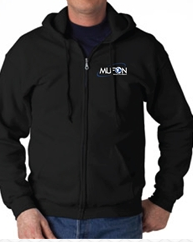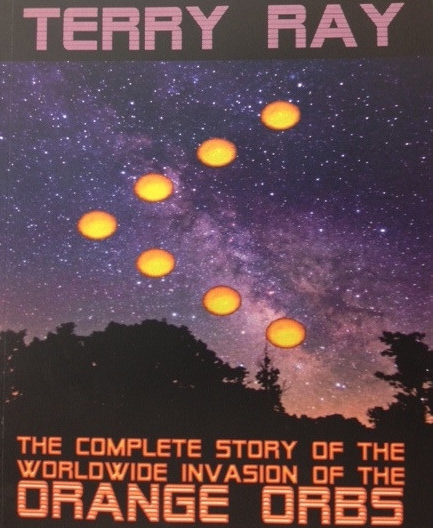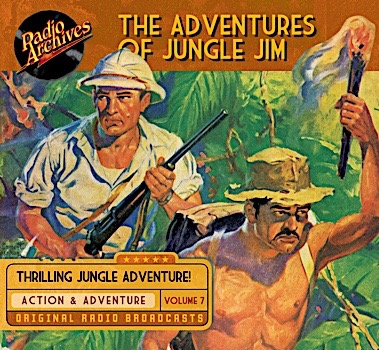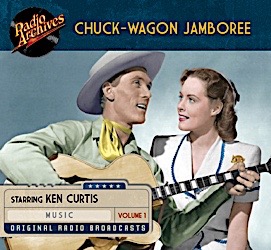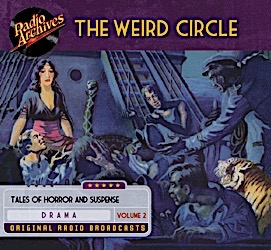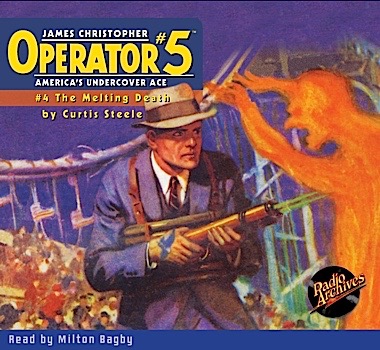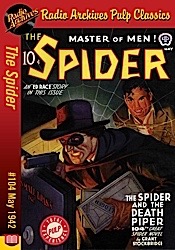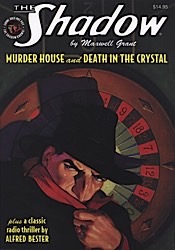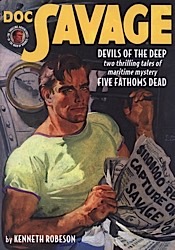| |||||||||||||||||||||||||||||||||||||
About
Besides posting book reviews, once in a while I will be posting articles on the subject of pulps. I hope we can generate more interest for the Blog. If you would like to share an article on the pulps, you can send me a message in the Comments of a post.
Saturday, February 28, 2015
MUFON
Friday, February 27, 2015
Radio Archives

February 27, 2015
Jungle Jim! The very name conjures up images of exotic locales, wild beasts and hostile natives. Jungle Jim braved these with the aid of his faithful Hindu companion Kolu as he traveled the wilds of southeastern Asia in search of adventure.
Jungle Jim is best remembered as the star of sixteen Columbia B-movies starring Johnny Weissmuller, fresh off his twelve-year stint as Tarzan, beginning in 1948. But Jungle Jim's history goes back more than a decade.
Produced by Jay Clark and often written by Gene Stafford, The Adventures of Jungle Jim was on the air weekly from 1935 to 1954. A combination of jungle danger and colonial politics, the show brought listeners tales of slave traders, pirates, foreign spies, wild beasts, poachers, hostile tribes, and, during World War II, the Japanese, as Jim often served as an Allied operative. Armed with his trusty .45 automatic, the adventurer searched for lost treasure and investigated such mysteries as ghosts and unknown islands. Throughout it all, Jungle Jim maintained a cool head.
Beginning with Tarzan, the pulp era was full of jungle characters. Jungle Jim is one of the unique ones, in that he wasn't a barely-literate loincloth-clad tree-dwelling wild man, but rather Jim Bradley, a hunter – a "great white hunter" in the mold of heroes of earlier popular fiction such as H. Rider Haggard's Allan Quatermain and Lord John Roxton from Arthur Conan Doyle's The Lost World.
In 1938, Gerald Mohr, who had a long career in radio, film and television, took over the role of Jungle Jim. In the 1930s, '40s and '50s, Mohr played over 500 parts on the radio, notably Raymond Chandler's hard-boiled detective Philip Marlowe. Series regulars included Jungle Jim's faithful aide, Kolu, a powerful Hindu giant (played by Juano Hernandez), and Lille DeVrille, who served as Jim's femme fatale (played first by Vicki Vola and later, Franc Hale).
This volume contains forty fifteen-minute episodes from 1940 and 1941, including the conclusion of "In Quest of Peter Stone" (#241-252) and and the beginning of "The Panama Canal" (#253-280), for ten hours of exciting and intelligent adventure.
10 hours - $14.99 Download / $29.98 Audio CDs
Special 50% discount Offer
featuring a set from the Music category
"Let's be happy, gather 'round, 'cause it's time for you and me to sing a song as we jog along to the Chuck-Wagon Jamboree!"
To western fans, he will always be best known as Festus Haggen, the grizzled and cantankerous sidekick of Sheriff Matt Dillon on the CBS television series "Gunsmoke." Complete with a three-day growth of beard and a dry-throated voice, Ken Curtis co-starred on the series for eleven years and became one of the best-loved comedic actors in television history.
But even die-hard fans of Dodge City may not realize that, in the years just after World War II, their favorite western deputy was, in fact, a singing cowboy -- the star of his own movie series at Columbia Pictures and a musical radio favorite to boot.
Joining Ken Curtis on this new series of shows, titled "Chuck-Wagon Jamboree," was a batch of talented studio musicians called The Novelty Aces, who would support Curtis musically in his solo numbers, appear as laughing and joking hillbilly hicks between songs, and also be featured in their own musical numbers. Art West, a talented musician and composer in his own right, was hired as both announcer and performer, and two of the singers would change their voices and appear as "The Goon Holler Twins" for twangy duets. Musically, the tone was decidedly down-home, with selections ranging all the way from Stephen Foster favorites to barbershop ballads, from spirituals to fiddle break-downs, and from popular tunes to a daily close-harmony hymn that would close each program on a peaceful note. Curtis would generally be featured in two songs per program, often choosing his selections from the popular recordings of western performers like Gene Autry, Roy Rogers, Bob Wills, and Al Dexter, and emphasizing the ballads that had made him a singing cowboy in the first place.
Heard today, "Chuck-Wagon Jamboree" still has much to offer. Reminiscent of "The Grand Old Opry" and, particularly, "The National Barn Dance," the series is a tuneful throwback to a simpler time when cowboys rode the range with their guitar by their side and everyone knew the old songs they had learned on their grandmother's knee. Taken from an original set of 16" Teleways transcription recordings and fully restored for beautiful, high-fidelity sound, here's your invitation to stop by the Jamboree and join in the fun. We bet you'll have a wonderful time.
Specially priced until March 12. 10 hours - $7.49 Download / $14.99 Audio CDs
Special 50% discount Offer
featuring a set from the Drama category
A good story is a good story, whether it was written two weeks ago, two decades ago, or even two centuries ago. And nowhere is that truer than in “The Weird Circle”, a half-hour anthology series that was first aired back in 1943.
The stories offered by “The Weird Circle” were generally adapted from popular fiction - popular fiction of the 19th century, that is. And since the focus was on horror and suspense, the macabre, atmospheric, and often ironic tales of such writers as Edgar Allan Poe and Honore de Balzac were a staple of its success. Also included were such familiar chestnuts as “Wuthering Heights” by Emily Bronte, Charles Dickens’ “The Queer Client”, Charlotte Bronte’s novel “Jane Eyre” (also a particular favorite of Orson Welles and his Mercury Theater company), and “The Strange Case of Dr. Jekyll and Mr. Hyde” by Robert Louis Stevenson. Stories of this vintage, rooted in the Victorian attitudes and morality of the 1800s, generally made for good radio drama; they were, after all, classics, familiar to anyone with a public school education. The primarily first-person narrative of most of the stories chosen made them relatively easy to convert into script form, too: introduce a narrator, establish the scene, and then carry on with the plot.
Heard today, it’s interesting to note how contemporary many of these stories still sound to modern listeners. “The Tell-Tale Heart”, first published in 1843, remains one of Edgar Allan Poe’s best short stories, revolving around the timeless themes of obsession, murder, and guilt. Mary Shelley’s “Frankenstein, or The Modern Prometheus,” dating from 1818, was one of the first novels to deal with science’s perilous but often irresistible urge to play God -- as well as the dire consequences of doing so. “Murder of the Little Pig”, based on a story by Emile Gaboriau, offers the tale of a detective who finds that the only witness to a crime is a dog! Lesser known stories by such well-known authors as Nathaniel Hawthorne, Sir Walter Scott, and the oft-neglected Edward George Bulwer-Lytton would later be adapted for radio by such popular anthology series as “Suspense” and “Escape”.
In this second Radio Archives collection, you’ll hear twenty more broadcasts from “The Weird Circle”, just as originally aired in 1944. As an extra bonus, we’ve uncovered the transcription disc containing the original openings and closings of the shows, allowing you to hear these programs in their original as-broadcast format for the first time in decades. If you’re familiar with some or all of the stories offered in this series, Radio Archives is sure you’ll enjoy revisiting your favorites in a different form. If you’ve read only a few of these stories - or, better still, if you’ve never read any of them - we promise that you’re in for a real treat.
So, bell keeper! Toll the bell, so that all may know that we are gathered again in...the Weird Circle!
Specially priced until March 12. 10 hours - $7.49 Download / $14.99 Audio CDs
16" Transcription Discs
Broadway Records Auction company is selling thousands of our transcription discs. These discs will be sold on a first come basis for the minimum bid. Browse through hundreds of UNSOLD transcription discs from the recent Broadway Records disc auction. Sold by Broadway Records.
Click here Service@RadioArchives.com to receive the current auction list with 600 transcription discs, which ends on March 1st.
Will Murray's Pulp Classics #74
by Frederick C. Davis writing as Curtis Steele
Read by Milton Bagby. Liner Notes by Will Murray
From out of the pages of Operator #5 magazine steps a dramatic hero who pits himself against threats to national security from all origins. Whether it’s a subversive internal threat, or a full-scale invasion from an enemy land, James Christopher stood ready and resolute to defeat it.
They called him Operator #5—undercover agent, man of many identities, patriotic protector of America’s sacred shores. Working for the U. S. Intelligence Service, his job is to root out subversive elements and stand as the first line of defense against foreign invasions from all quarters. Aided by street-smart Tim Donovan and newspaperwoman Diane Elliott, Jimmy Christopher was the James Bond of the 1930s! But can even these resourceful comrades hold the line when the world is filled with ambitious dictators bent on conquering America?
James Christopher did not technically belong to the U. S. Secret Service. He was a top agent for an America’s unnamed counter espionage agency. It was in his blood. His father, John Christopher, retired from the same agency years before. Answerable only to his superior, Z-7, and carrying a letter from the President of the United States identifying him as Operator #5, Jimmy Christopher played for keeps. He carried a rapier sewn into his belt, and in a golden skull hanging from his watch-chain was a reservoir of deadly poison to be taken in the event of capture.
Originally written by master pulpsmith Frederick C. Davis, the Operator #5 series was a clear forerunner of the spy and espionage genre, which exploded in the 1960s when President John F. Kennedy happened remark that he enjoyed reading Ian Fleming’s James Bond novels. The first Bond film, Dr. No, was released in 1962. Soon, America was surrounded by spies. The Man from U.N.C.L.E., Our Man Flint, and Nick Carter, Killmaster were just a few of the most prolific. Jimmy Christopher was on the job a generation before them all, blazing the espionage trail, and keeping America safe from fascism and other wicked isms.
For his fourth mission, Jimmy Christopher battles The Melting Death. Here is how the editors blurbed it in the July, 1934 issue of Operator #5 magazine:
Out of the blue it struck––that dread, mysterious force, dealing death, destruction and misery to millions. America found herself stripped of her strongest defenses as battleships, huge guns, skyscrapers, factories and transportation systems crumbled to dust before the voracious flame. No one could tell where it came from; where it would next strike; no one was safe from its hot, devouring maw. An entire nation stood crippled, paralyzed by panic as Operator #5, alone, fought to save America from the red ruin loosed upon it.
Into this unprecedented crisis plunged Jimmy Christopher. Only one man, but a man who embodied the American spirit—and stands prepared to perish to protect his country.
The Melting Death is read with tightly-wound tension by Milton Bagby.
5 hours - $9.99 Download / $19.98 Audio CDs
New Will Murray's Pulp Classics eBooks
The best of timeless Pulp now available as cutting edge eBooks! Will Murray's Pulp Classics brings the greatest heroes, awesome action, and two fisted thrills to your eReader! Presenting Pulp Icons such as the Spider, G-8 and His Battle Aces, Operator #5 as well as wonderfully obscure characters like the Octopus and Captain Satan. Will Murray's Pulp Classics brings you the best of yesterday's Pulp today!
The Spider #104 May 1942 The Spider And The Death Piper
As the Pied Piper of Hamelin piped the town’s children to doom, so did the weird, compelling music of the Death Piper lure the people of Martinsville to suicide, singly at first, and later... in a mad stampede! Could Richard Wentworth, almost enslaved by the ghastly music, assume the Spider’s role and fight the overwhelming forces of the monster called the Piper?
As the Pied Piper of Hamelin piped the town’s children to doom, so did the weird, compelling music of the Death Piper lure the people of Martinsville to suicide, singly at first, and later... in a mad stampede! Could Richard Wentworth, almost enslaved by the ghastly music, assume the Spider’s role and fight the overwhelming forces of the monster called the Piper?
Total Pulp Experience. These exciting pulp adventures have been beautifully reformatted for easy reading as an eBook and features every story, every editorial, and every column of the original pulp magazine. As a special bonus, Will Murray has written an introduction especially for this series of eBooks. Another epic exploit of America’s best-loved pulp-fiction character of the 1930s and 1940s: The Spider — Master of Men! Richard Wentworth — the dread Spider, nemesis of the Underworld, lone wolf anti-crime crusader who always fights in that grim no-man’s land between Law and lawless — returns in vintage pulp tales of the Spider, reissued for today’s readers in electronic format. $2.99.
All eBooks produced by Radio Archives are available in ePub, Mobi, and PDF formats for the ultimate in compatibility. When you upgrade to a new eReader, you can transfer your eBooks to your new device without the need to purchase anything new.
Five Doc Savage reprints on sale!
For the next two weeks these five Doc Savage reprints Volume 62, 66, 67, 68, and 69 are being discounted by 10%.






by Will Murray and Lester Dent, writing as Kenneth Robeson, cover illustration by Joe DeVito
When William Harper Littlejohn unearths a shadowy figure transfixed in ice, the renowned archeologist understands that he has made the most momentous discovery of his brilliant career. For inscribed over the frozen form is this chilling warning:
“IF I STILL LIVED, MANKIND WOULD TREMBLE!”
Who is this monster? Why does his name strike terror into the hearts of brave men? Can even Doc Savage control him once he breaks free of his icy tomb?
From the Gobi Desert to war-torn Free China, the Man of Bronze and his fighting crew battle a threat so terrifying that it could change the course of human history…. Softcover $24.95
Who knows what evil lurks in the hearts of men? The Shadow knows! Lamont Cranston takes center stage in two thrilling mysteries by Walter B. Gibson writing as “Maxwell Grant.” First, the peace and quiet of a countryside give way to criminal warfare as The Shadow stalks the hidden mastermind of the “Murder House.” Then, in “Death in the Crystal,” Margo Lane’s visit to the Tibetan fakir Mahatma Xanadu sets The Shadow on the trail of strange crime that leads to a criminal mastermind discovering The Shadow’s secret identity as Lamont Cranston. BONUS: a classic Shadow adventure from the Golden Age of Radio! This instant collector’s item showcases both classic color pulp covers by George Rozen and Modest Stein and the original interior illustrations by Tom Lovell and Paul Orban, with original commentary by popular culture historians Will Murray and Anthony Tollin. Double Novel Reprint $14.95
The pulp era's legendary superman returns in thrilling maritime mysteries by Harold A. Davis and Lester Dent writing as "Kenneth Robeson." First, with a million-dollar bounty on his head, Doc Savage hunts for the "Devils of the Deep" after international ships are seized by a mysterious "sea monster." Then, modern-day piracy is suspected when the Navy's newest submarines disappear in "Five Fathoms Dead" ... but where is the Man of Bronze? This deluxe pulp reprint leads off with the classic color pulp cover by Emery Clarke, and also features the original interior illustrations by Paul Orban and historical commentary by Will Murray, author of fifteen Doc Savage novels. Double Novel Reprint $14.95




The last few Spider and Terror Tales Replicas are reduced in price and
are in the Bargain Basement along with Pulp Reprints, and cassettes.
Comments From Our Customers!
Robert G writes:
Several episodes in The Weird Circle, Volume 2 were some of the first examples of OTR I ever had the chance to listen to. In recent years I've been on the hunt to find the highest quality copies of this show possible and I can say with absolute certainty that my search can end. I've never heard these episodes with the kind of amazing clarity as I have here. The team at RadioArchives has consistently proven themselves the best at OTR restoration and this set is yet another testement to that.If you've thought about purchasing any of the fine products from Radio Archives but been hesitant about it, please believe me when I say you won't regret it. It only took my purchase of this product to put any of my own fears to rest. And with their policy of making their digital editions half the price of the physical CD sets, you really can't go wrong. Give it a shot. You'll be glad you did.
Several episodes in The Weird Circle, Volume 2 were some of the first examples of OTR I ever had the chance to listen to. In recent years I've been on the hunt to find the highest quality copies of this show possible and I can say with absolute certainty that my search can end. I've never heard these episodes with the kind of amazing clarity as I have here. The team at RadioArchives has consistently proven themselves the best at OTR restoration and this set is yet another testement to that.If you've thought about purchasing any of the fine products from Radio Archives but been hesitant about it, please believe me when I say you won't regret it. It only took my purchase of this product to put any of my own fears to rest. And with their policy of making their digital editions half the price of the physical CD sets, you really can't go wrong. Give it a shot. You'll be glad you did.
Cheryl Reaves writes:
Thanks guys. Received shipment and am very pleased. You are the best. Thanks for the free DVD.
Thanks guys. Received shipment and am very pleased. You are the best. Thanks for the free DVD.
Stephen Schmehl writes:
This 1942 story, The Shadow vs The Hydra in Shadow #4 was really good! This story used a group of early Gibson conventions which I enjoyed and kept me guessing through till the end. I loved the cover as well!
This 1942 story, The Shadow vs The Hydra in Shadow #4 was really good! This story used a group of early Gibson conventions which I enjoyed and kept me guessing through till the end. I loved the cover as well!
If you'd like to share a comment with us or if you have a question or a suggestion send an email to Service@RadioArchives.com. We'd love to hear from you!
3 ways to order.
1. Website RadioArchives.com
2. Phone 800-886-0551
3. Email Reply to this email with what you want to order. Payment information will be sent to you.
Whichever method you prefer, order by 7:30pm EDT and your order is mailed today!
Subscribe to:
Comments (Atom)










